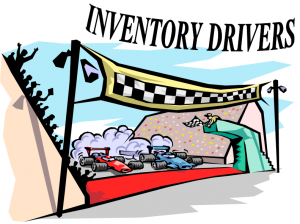 Why do most organizations do physical inventories at least once a year? Is it because their inventory accuracy is so bad they do not know what they really have in stock? Is it a way of finding out where the stock is in the facility? Is it just somebody’s bad idea of a joke? Actually, the main reason for the annual physical inventory is that the government requires all organizations to report on the value of the organization which includes the inventory value. An outside financial auditor must sign off on the reported value and if they are not comfortable that the book value is accurate they will require a physical inventory to “prove” the value. Note that they are interested in the total value, not specific item counts. This means that if the errors cancel each other out and the total value is within acceptable limits the count will be accepted and entered in the system as the inventory record. With regards to inventory accuracy, we the inventory control world are less interested in the value and more interested in the specific count of the items. The value may be right but the counts may be wrong and being short one or more items from the “official” count can create massive problems. As an example I would refer you to a poem published in the 1700’s by Benjamin Franklin called “For Want of a Nail”. I won’t go into the full poem but in essence the lack of a nail resulting in losing a kingdom. Similarly, being short on a count can lead to production or shipment shutdowns and potentially significant costs. This is why many companies have implemented or investigated Cycle Count programs – they are inherently more accurate and cheaper in the long run than a Physical Inventory. (By the way, the poem predates Benjamin Franklin and is still around today. Obviously inventory issues have plagued organizations for a very long time. I’m sure that at some point a long time ago there was a group of cavemen standing around shouting at some poor stock keeper – “What do you mean there are only 2 spears? There should be 20!”)
Why do most organizations do physical inventories at least once a year? Is it because their inventory accuracy is so bad they do not know what they really have in stock? Is it a way of finding out where the stock is in the facility? Is it just somebody’s bad idea of a joke? Actually, the main reason for the annual physical inventory is that the government requires all organizations to report on the value of the organization which includes the inventory value. An outside financial auditor must sign off on the reported value and if they are not comfortable that the book value is accurate they will require a physical inventory to “prove” the value. Note that they are interested in the total value, not specific item counts. This means that if the errors cancel each other out and the total value is within acceptable limits the count will be accepted and entered in the system as the inventory record. With regards to inventory accuracy, we the inventory control world are less interested in the value and more interested in the specific count of the items. The value may be right but the counts may be wrong and being short one or more items from the “official” count can create massive problems. As an example I would refer you to a poem published in the 1700’s by Benjamin Franklin called “For Want of a Nail”. I won’t go into the full poem but in essence the lack of a nail resulting in losing a kingdom. Similarly, being short on a count can lead to production or shipment shutdowns and potentially significant costs. This is why many companies have implemented or investigated Cycle Count programs – they are inherently more accurate and cheaper in the long run than a Physical Inventory. (By the way, the poem predates Benjamin Franklin and is still around today. Obviously inventory issues have plagued organizations for a very long time. I’m sure that at some point a long time ago there was a group of cavemen standing around shouting at some poor stock keeper – “What do you mean there are only 2 spears? There should be 20!”)
We have touched on cycle counting a couple of times already in other posts but I wanted to go into this topic in more detail. While a Cycle Count program is definitely a desirable tool it will not work on its own. Without support from many other factors it will just become an exercise in frustration for everyone involved. Some of these other factors are timely movement reporting, process discipline, clear material identification, integrated IT systems and dedication to organized storage. Just to be clear, while fixing the incorrect amounts is important; it is NOT the key to a successful cycle count program. The key is in identifying the reason for the inaccurate count and putting a fix into the appropriate process to eliminate the reason for the failure. Cumulatively, all these changes will predispose your process to having and maintaining an accurate count. The better your accuracy, the less safety stock you will need to ensure acceptable customer service levels. Reducing inventory will make it easier to maintain a better accuracy level…thereby creating a self-reinforcing positive improvement cycle. Increased accuracy also reduces numerous other costs such as expediting cost, production and shipping delays, excessive searching for “lost” material and better lot control (especially critical in a FIFO environment). All of these combine together to make Cycle Counting one of the more important Inventory Drivers when trying to control and optimize your inventory levels.
While I am not going to use this forum to discuss how to set up a cycle count program (contact me directly if you want to discuss that) there are a couple of precursors that I do consider important. First and foremost, no cycle count program will work well without an embedded and effective Root Cause Analysis culture in place. By culture I mean a process that is so deeply embedded that everyone in the organization accepts it, is involved in it and believes that it is of critical value to their customers. Another way to think of it is Continuous Improvement on steroids. It is even better if Appreciative Inquiry is also part of this process. (Never heard of Appreciative Inquiry? Think of it as the mirror image of Root Cause. If Root Cause can be described as “something went wrong – how do we stop it from repeating”. Appreciative Inquiry can be described as “something went right – how do we make sure it happens more often”. Believe me when I say that Appreciative Inquiry is much more difficult than Root Cause but it is also probably more effective for the long term growth of the organization.
The second most important precursor is discipline. By that I mean everyone having the internal discipline to always do the right thing, no short cuts, and recording all transactions in a timely fashion. For example, when a back ordered material arrives at the door and needs to be shipped out immediately, the receiving paperwork still needs to be completed before the shipping documentation and both need to be done immediately. Always keep in mind that the transaction is not complete (and the inventory is wrong) until the paperwork is completed IN THE SYSTEM. Just writing it down and submitting it for keypunching at a later time is not sufficient. (While a real time RF system is not a requirement it will definitely improve inventory accuracy.)
The final precursor is similar to the second. Everyone in the company must have a commitment to cleanliness and organization. The old saying “a place for everything and everything in its place” sums it up perfectly. If there are pieces of broken pallets on the floor, anybody (including management) should put them in the garbage, If something is not where it belongs it should be put back immediately. Floors should be clean and clear, walls should be clean and accessible, machinery should be in good repair and available as needed. Working conditions influence mind sets. If the work area is messy and disorganized, people will develop a tendency to take short cuts or not follow through completely. In the end a company’s culture will decide whether a program such as Cycle Counting will succeed or not.
Are you considering implementing a Cycle Count Program?
Are all the precursors in place in your organization? Are you ready to implement a SUCCESSFUL Cycle Count program? Contact Ed White at Jade Trillium Consulting to discuss whether this will help your organization and how best to proceed.
Next posting we will explore Service Levels – How does a customer service measure affect Inventory Management? In the meantime, enjoy thinking about Cycle Counting. Talk to your friends and co-workers about their experience and thoughts on this topic, especially what it means for your organization. And, as always, I would love to hear back on your (and their) thoughts. Just fill in the comment box below along with your contact information to let me know what you think.


